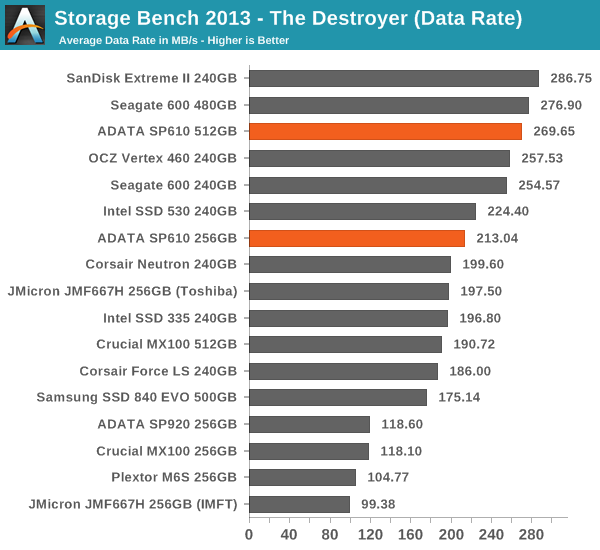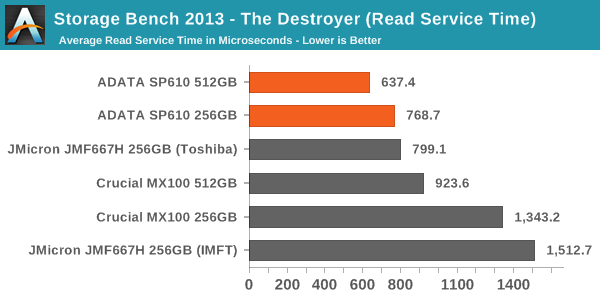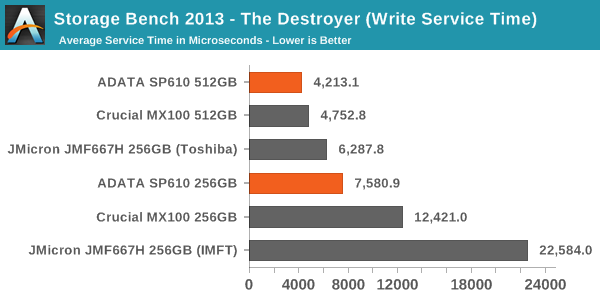ADATA Premier SP610 SSD (256GB & 512GB) Review: Say Hello to an SMI Controller
by Kristian Vättö on June 27, 2014 2:00 PM EST- Posted in
- Storage
- SSDs
- ADATA
- SP610
- Silicon Motion
AnandTech Storage Bench 2013
Our Storage Bench 2013 focuses on worst-case multitasking and IO consistency. Similar to our earlier Storage Benches, the test is still application trace based - we record all IO requests made to a test system and play them back on the drive we are testing and run statistical analysis on the drive's responses. There are 49.8 million IO operations in total with 1583.0GB of reads and 875.6GB of writes. I'm not including the full description of the test for better readability, so make sure to read our Storage Bench 2013 introduction for the full details.
| AnandTech Storage Bench 2013 - The Destroyer | ||
| Workload | Description | Applications Used |
| Photo Sync/Editing | Import images, edit, export | Adobe Photoshop CS6, Adobe Lightroom 4, Dropbox |
| Gaming | Download/install games, play games | Steam, Deus Ex, Skyrim, Starcraft 2, BioShock Infinite |
| Virtualization | Run/manage VM, use general apps inside VM | VirtualBox |
| General Productivity | Browse the web, manage local email, copy files, encrypt/decrypt files, backup system, download content, virus/malware scan | Chrome, IE10, Outlook, Windows 8, AxCrypt, uTorrent, AdAware |
| Video Playback | Copy and watch movies | Windows 8 |
| Application Development | Compile projects, check out code, download code samples | Visual Studio 2012 |
We are reporting two primary metrics with the Destroyer: average data rate in MB/s and average service time in microseconds. The former gives you an idea of the throughput of the drive during the time that it was running the test workload. This can be a very good indication of overall performance. What average data rate doesn't do a good job of is taking into account response time of very bursty (read: high queue depth) IO. By reporting average service time we heavily weigh latency for queued IOs. You'll note that this is a metric we have been reporting in our enterprise benchmarks for a while now. With the client tests maturing, the time was right for a little convergence.

Well, this doesn't make much sense. The service times aren't anything special, yet the average data rate is surprisingly high. For instance the 256GB JMF667H drive has lower service time but the average data rate is lower.

For this to make some sense, let's look at the service times for reads and writes separately.


Now this makes more sense. Due to the relatively poor IO consistency of the SP610, the write service times are quite high. That increases the average service time substantially but the impact on average data rate is smaller, and the reason for that is quite simple.
To keep thing simple, imagine that it takes five seconds to write 128KB of sequential data and one second to write 4KB of random data. In other words, it takes six seconds to write 132KB of data, which works out to be 22KB/s. However, the 128KB write operation completed at 25.6KB/s, whereas the throughput of the 4KB write operation was only 4KB/s. 22KB/s is certainly much closer to 25.6KB/s than 4KB/s, meaning that the average data rate gives more emphasis to the large transfer because frankly it counts more when looking at amount of data that was transferred.
But now add in the service time. It took a total of six seconds to complete two IOs, which means that the average service time is three seconds. It doesn't matter that the other IO is much larger because service time only looks at the completion time of an IO, regardless of its size. Because of that, the service times give more information about small IO performance than the average data rate where the small IOs are buried under the larger transfers.
In the context of the SP610, this means that it performs well with large IOs as the data rate is high. Only about 30% of the IOs in the trace are 4KB, whereas 40% are 64KB and 20% are 128KB. With small IOs the performance is not bad but for instance the JMF667H does slightly better, resulting in lower service times. Despite the mediocre performance consistency on the previous page, overall the SP610 does very well in the 2013 Storage Bench and potentially offers users better performance than the MX100, 840 EVO and JMF667H.










24 Comments
View All Comments
mapesdhs - Friday, June 27, 2014 - link
I'd say go with the EVO; Samsung drives have excellent long term consistency, at
least that's what I've found from the range of models I've obtained.
Looking at the initial spec summary, the SP610 just seems like a slower MX100,
which puts it below the EVO or any other drive in that class, so unless it's priced
like the MX100 I wouldn't bother with it.
Kristian, may I ask, why are there so many models missing from the tables? eg.
Vector/150, Neutron GTX, M500, V300, Force Series 3, M550, M5Pro Extreme,
etc. I'm glad the Extreme II is there though, that's quite a good model atm.
Would be interesting to include a few older ones too, ie. to see how performance
has moved on from the likes of the Vertex3/4 and others from bygone days. I still
bag Vertex4s and original Vectors if I can as they hold up very well to current models,
though this week I snapped up four 128GB Extreme IIs (45 UKP each) as their IOPS
rating for a 128GB seems ideal for tasks like a big Windows paging drive in a system
with 64GB RAM.
Ian.
PS. Obvious point btw, perhaps ADATA can improve the consistency issue with a fw update?
stickmansam - Friday, June 27, 2014 - link
The SP610 is actually about the same as the EVO and MX100 it seems based on overall resultsThe firmware and controller actually seem pretty competitive
I do agree that more drives should be compared if possible. Even the Bench tool seems to be missing drives that were in reviews in the past.
dj_aris - Friday, June 27, 2014 - link
Why are we still testing sata 3 drives anyway?mapesdhs - Friday, June 27, 2014 - link
Because the vast majority of people still want to know how they perform. Rememberthere will be many with older SSDs who are perhaps considering an upgrade by now,
from the likes of the venerable Crucial M4/V4, Vertex2/3, older Intels, Samsung 830, etc.
For newer reviews, it's less the sequential rates and more about the random behaviour,
consistency, and other features like encryption that people want to know about now,
especially with so many being used in laptops, notebooks, etc. I also like to know how
what's being offered anew compares wrt pricing, ie. are things really getting better?
It's great that 1TB models are finally available, but I still yearn for the day when SSDs
can exceed HDDs in offered capacities. I read that SanDisk seem determined to push
forward this is as quickly as possible, moving to 2TB+ next year. I certainly hope so.
Nothing wrong with having 4TB+ rust-spinners, but backing them up is a total pain (and
quite frankly anyone who uses a 4TB non-Enterprise SATA HDD to hold their precious
data is nuts). By contrast, having 4TB+ SSDs at least means doing backups wouldn't
be slow. When I use Macrium to create a backup image of a 256GB C-drive SSD onto
some other SSD, the speeds achieved really are impressive.
I guess the down side will be that, inevitably at first, high capacity SSDs will be expensive
purely because it'll be possible to sell them at high prices no problem, whatever they
actually cost to make. I just hope at least one vendor will break away from the price
gouging for a change and really move this forward; if nothing else, they'll grab some
hefty market share if they do.
Ian.
name99 - Friday, June 27, 2014 - link
"The benefit of ARC is that it is configurable and the client can design the CPU to fit the task, for example by adding extra instructions and registers. Generally the result is a more efficient design because the CPU has been designed specifically for the task at hand instead of being an all around solution like the most ARM cores are."This is marketing speak. In future, rather than just repeat the claims about why "CPU you've never heard of is more awesome than anything you've actually heard of" please provide numbers to back up the claim, or ditch the PR speak.
If this CPU is "more efficient" than, e.g., an ARM (or MIPS or PPC) competitor, let's have some power numbers.
My complaint is not that they are using ARC --- they can use whatever CPU they like. My complaint is that the two sentences I quoted are absolutely no different from simply telling us, e.g. "this SSD is more efficient than its competitors" with no data to back that up. Tech claims require data. If MSI aren't willing to provide data to back up a tech claim, you shouldn't be printing their advertising in a tech story.
Kristian Vättö - Saturday, June 28, 2014 - link
Nothing regarding the controller's architecture came from ADATA or SMI. In fact, I got the ARC part from Tom's Hardware, although I added the parts about ARC's benefits. If I just put ARC there and leave out the explanation, what is the usefulness of that? Yay, yet another acronym that means absolutely nothing to the reader unless it is opened to them.To be clear, I did not mean that an ARC CPU is always more efficient in every task. However, for a specific task with a limited set of operations (like in an SSD), it usually is because the design can be customized to remove unnecessary features or add ones that are needed. It's not an "ARM killer", it is simply an alternative option that can suit the task better by removing some of the limitations that off-the-self CPU designs have. Ultimately the controller is just a piece of silicon and everything it does is operated by the firmware.
epobirs - Saturday, June 28, 2014 - link
After all of these years, when I see the Argonaut name I find myself wondering when a new Star Glider will be published. (Star Fox doesn't count other than spiritually.)s44 - Saturday, June 28, 2014 - link
How do we know this is even going to be the controller in future units of this model? The bait-and-switch with the Optima deserves more than passing mention, I think.hojnikb - Saturday, June 28, 2014 - link
Well, to be fair, sandforce version of optima is faster, so really, you're getting a better drive.Still not okay, but not nearly as bad as kingston's bait and switch.
smadhu - Sunday, June 29, 2014 - link
To muddy the controller waters further, we are planning to launch a fully open source NVM Express controller this year. This is from IIT-Madras, an Indian university in conjunction with the IT Univ. of Copenhagen. The development itself is in public, the main source is at bitbucket.org/casl/ssd-controller. This is part of a larger open storage stack project called lightstor, see lightstor.org. Lightstor is an extremely ambitious effort to reinvent storage from the controller up to the application stack. The SW stack, called Lightnvm is up and running on a Linux branch. Google Lightnvm. There is also an emulator to run it now.We will be launching a Xilinx based PCIe card with our controller IP and open source CPU (1-4 cores). CPU is based on the RISC-V ISA from UCB, another partner of ours. The PCIe EP and ONFI will have to be proprietary initially but we will be completing our open source ONFI 4.0 early next year. All PHY will still have to be 3rd party since we do not want to get into analog PHY development.
Add a SATA controller instead of PCIe and you have a SATA SSD.
All HW source is BSD licensed, so anyone can download it and tape it out with no copyleft hassles. Final version should be the fastest controller out there. Idea is to beat every controller out there and not just launch a univ. test bed. Core currently runs at 700 Mhz on a 32 bit datapath.
If anybody wants to help in testing, bench-marking or coding drop us a note. If nothing else, have fun going through the source of an SSD controller. It is a lot of fun. Language is Bluespec, a very high level HDL which is easy for SW geeks to understand. Hides a lot of the HW. plumbing. Comes from MIT, another collaborator of ours so we are partial to the language.
Hopefully we will do to the storage world what Linux did to the OS world !
The core is being bench-marked right now, hope to publish something by early winter.
I apologize for what technically is an ad for our project but I figure a BSD licensed open source SSD controller qualifies for free ads !